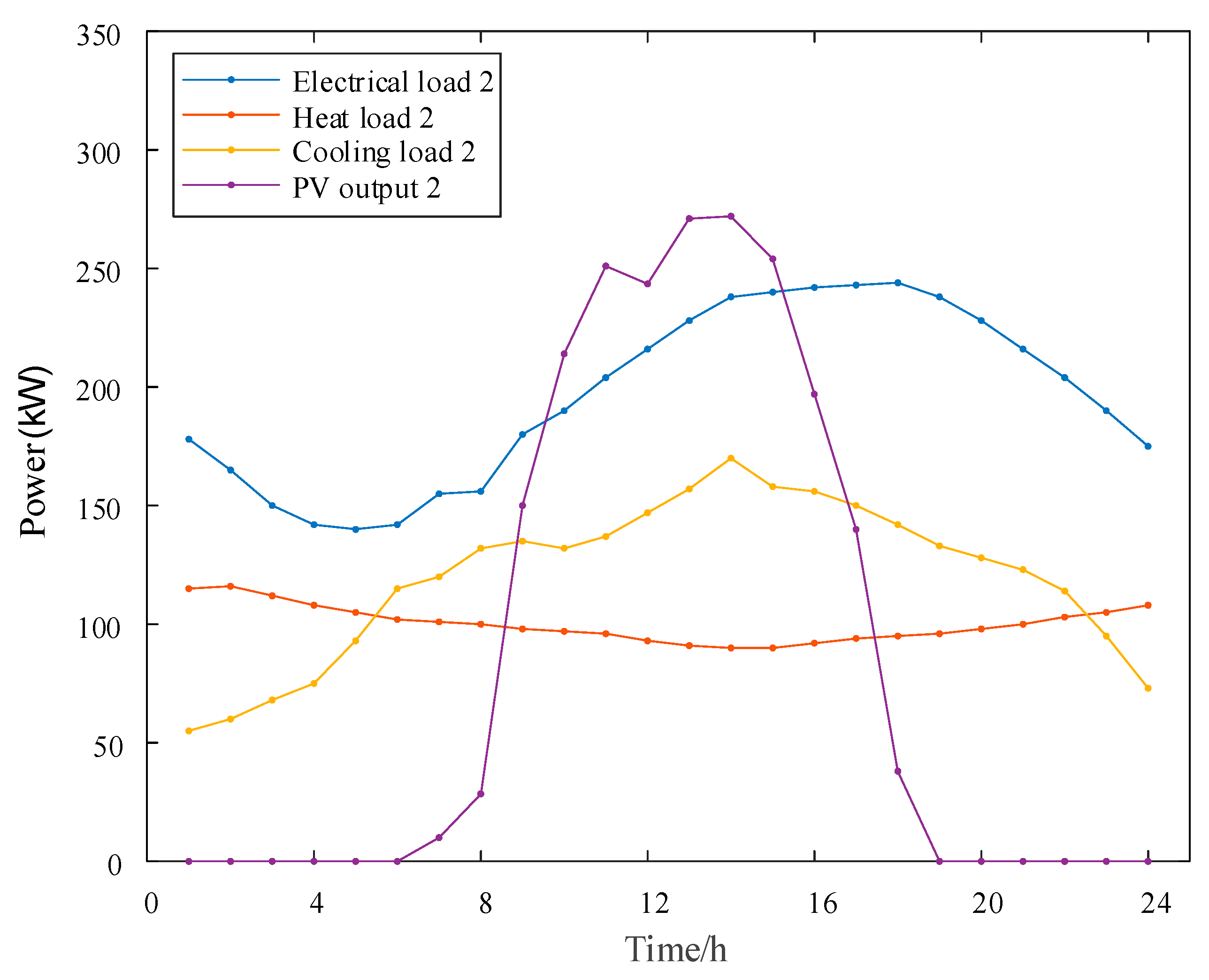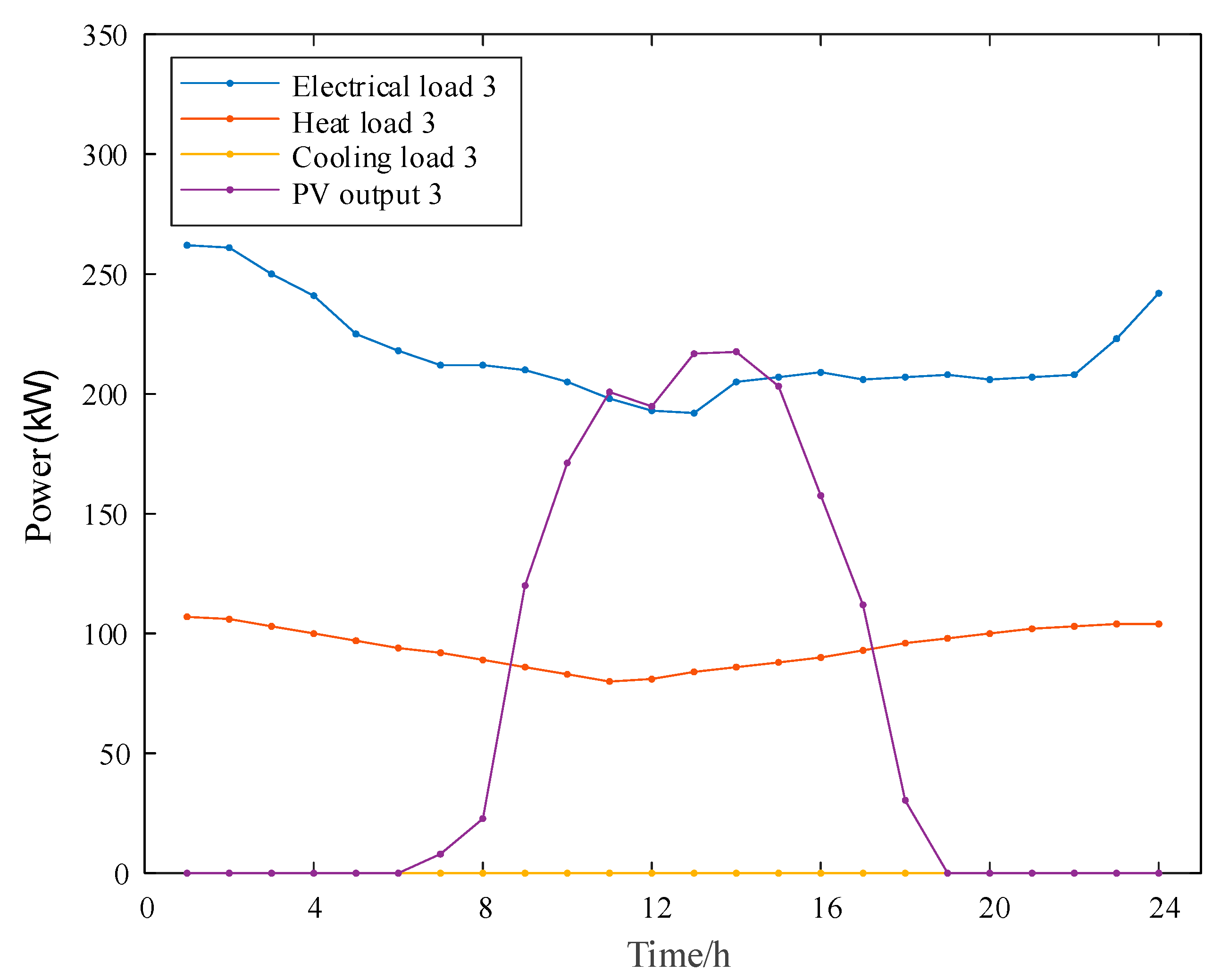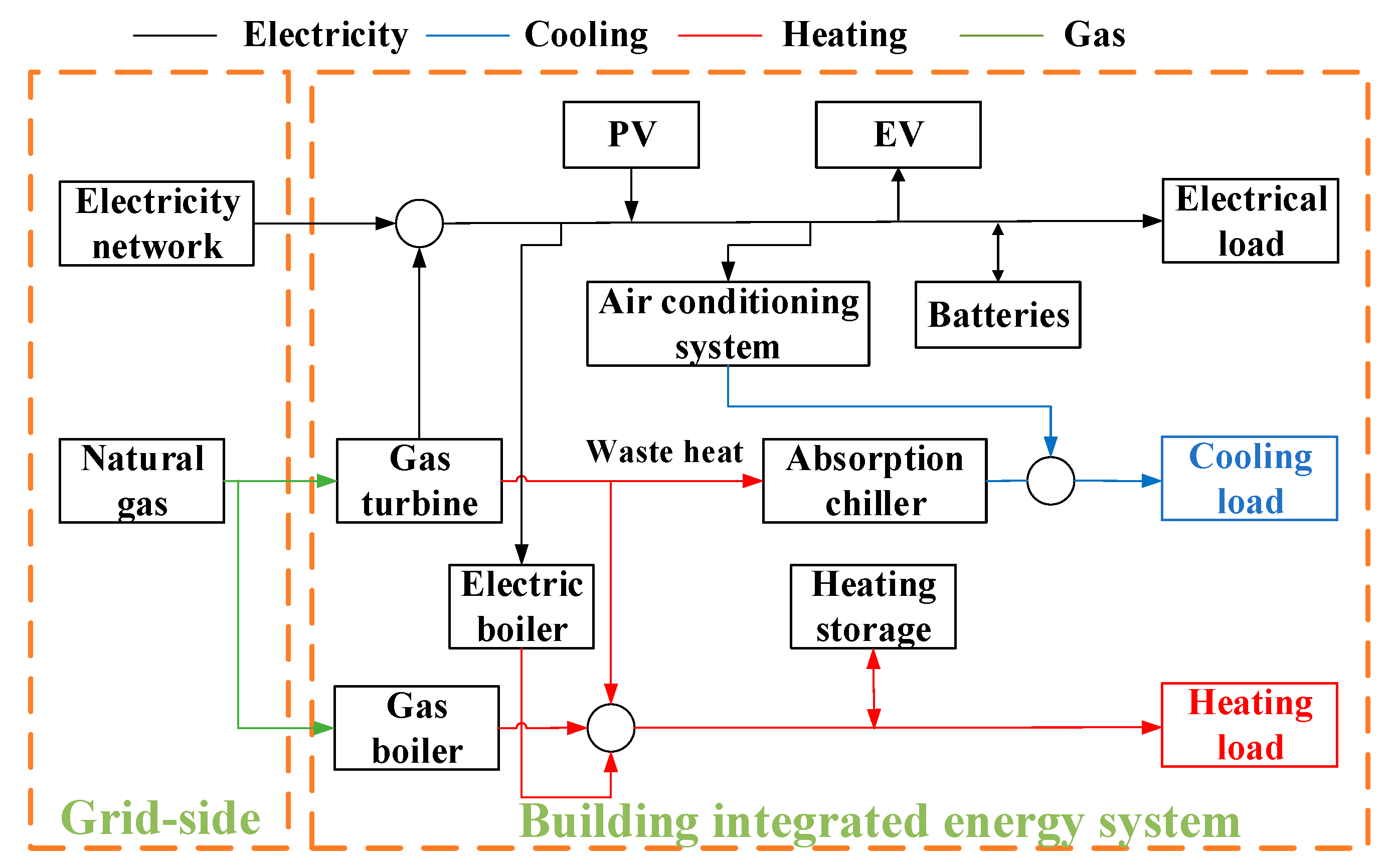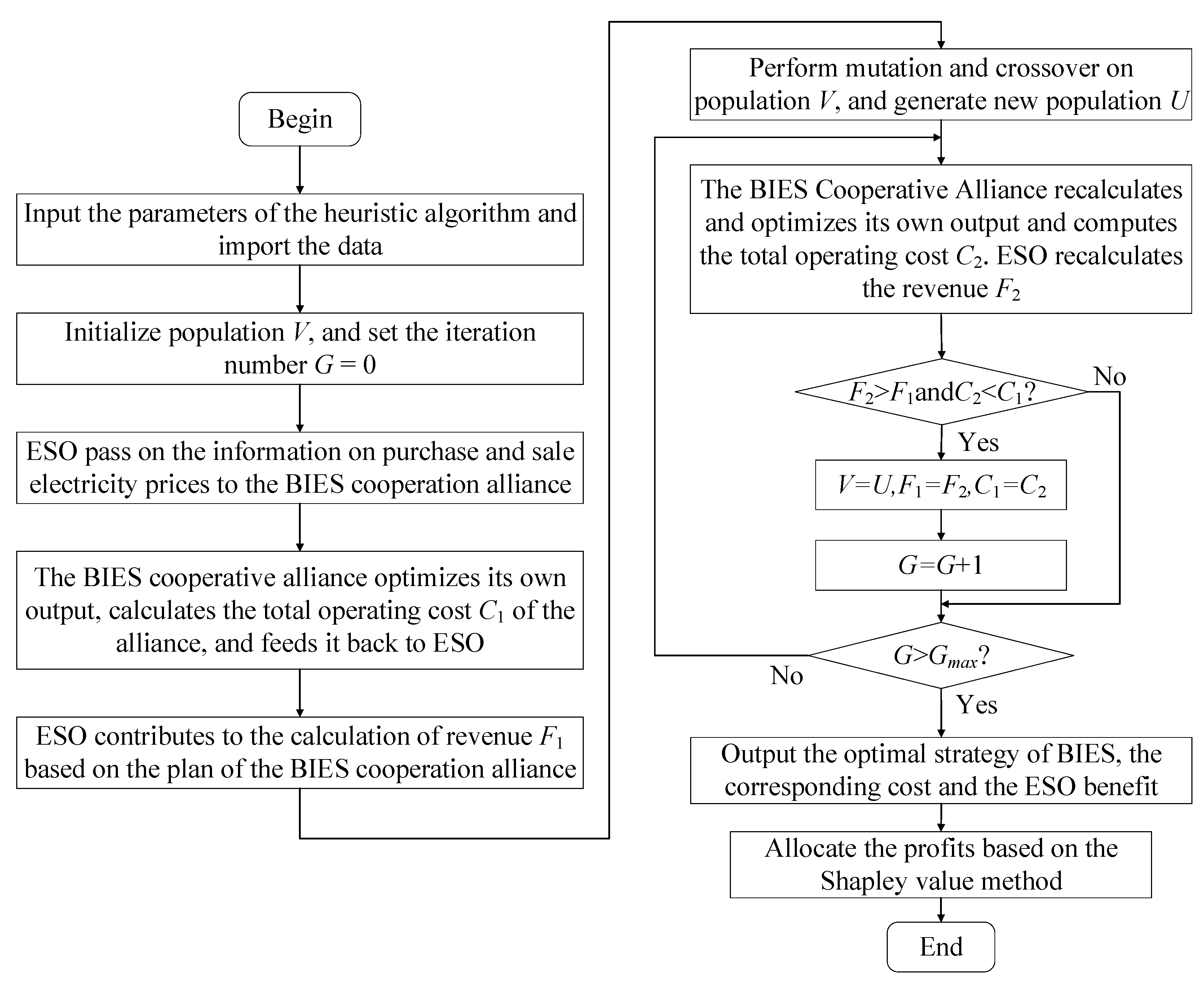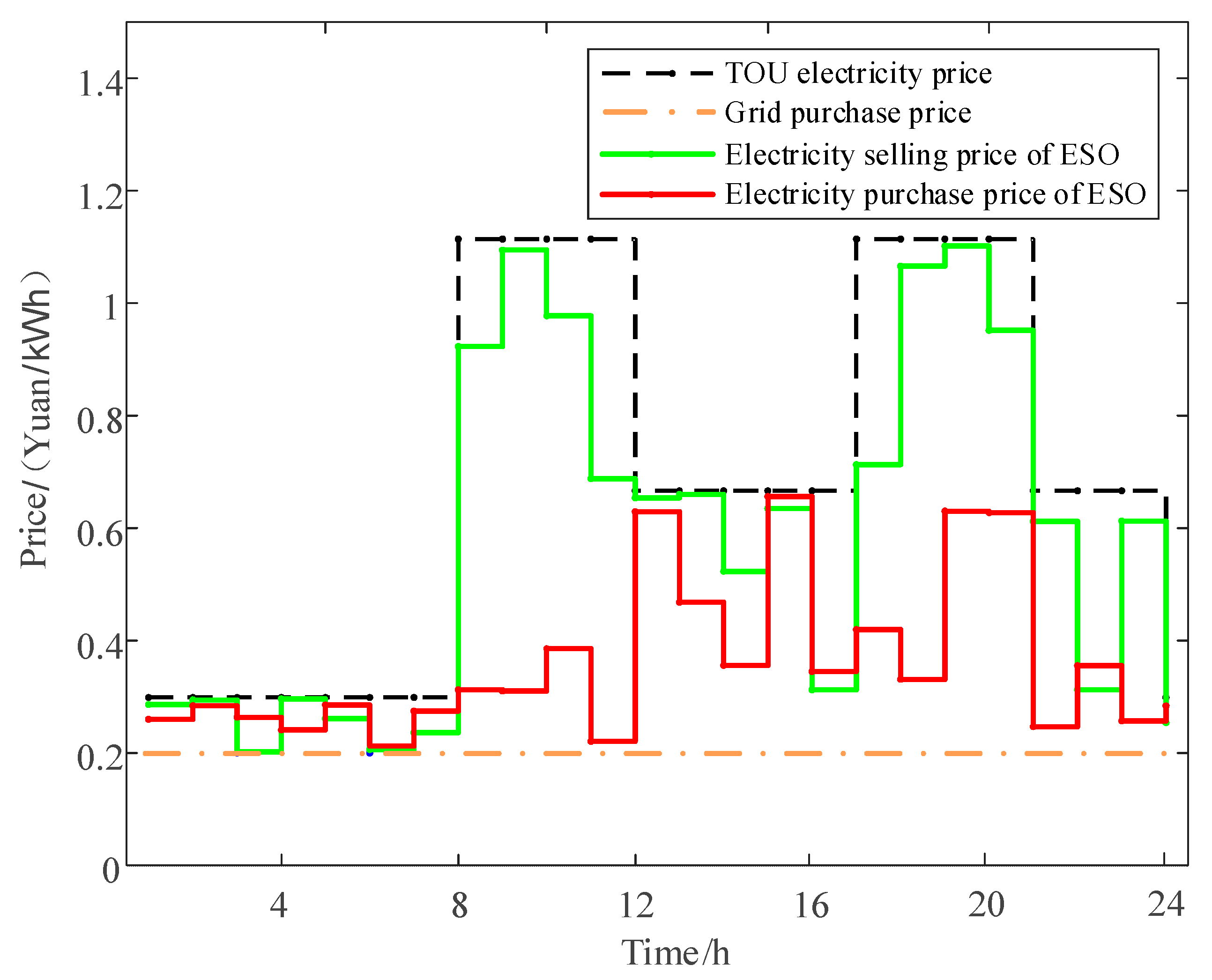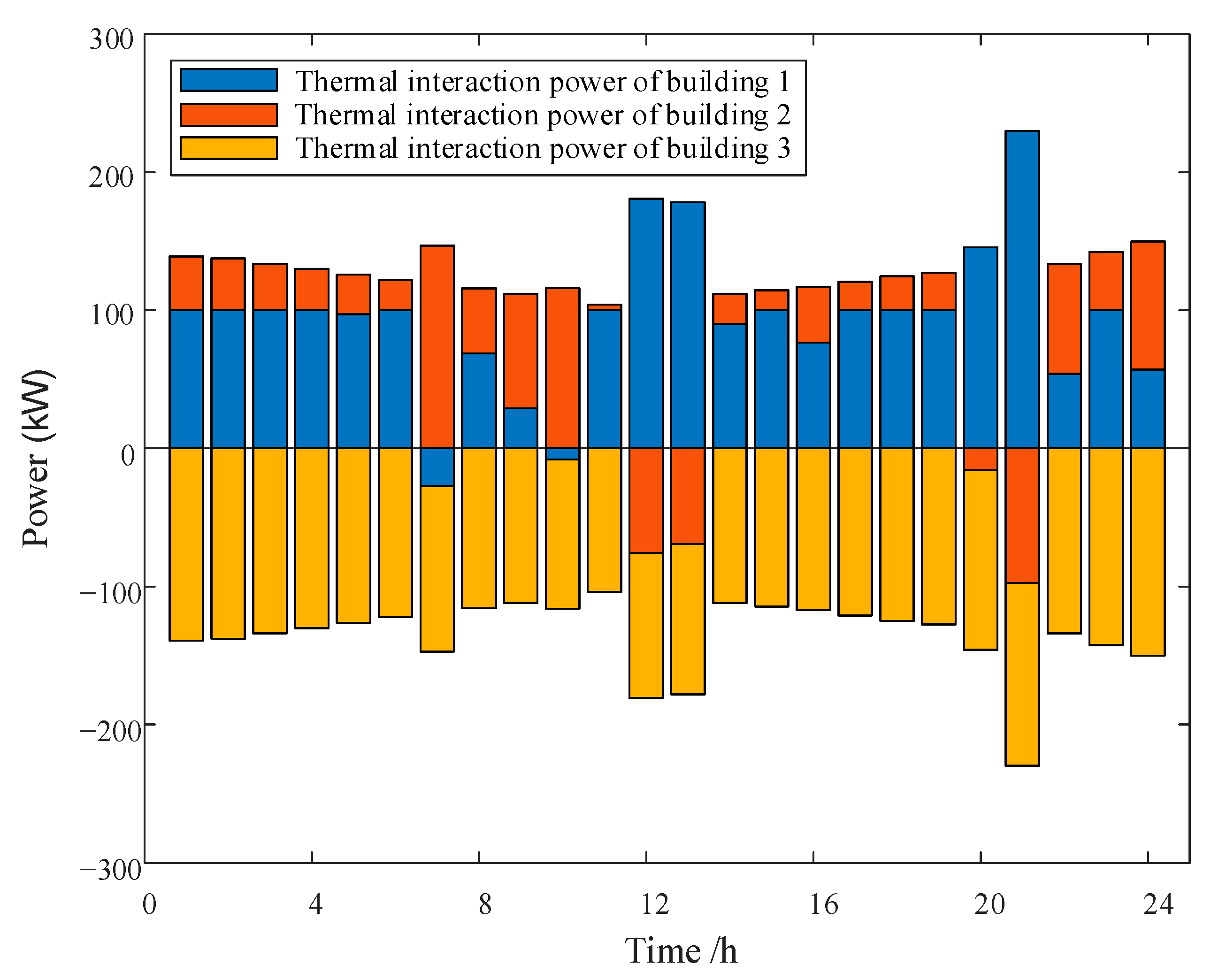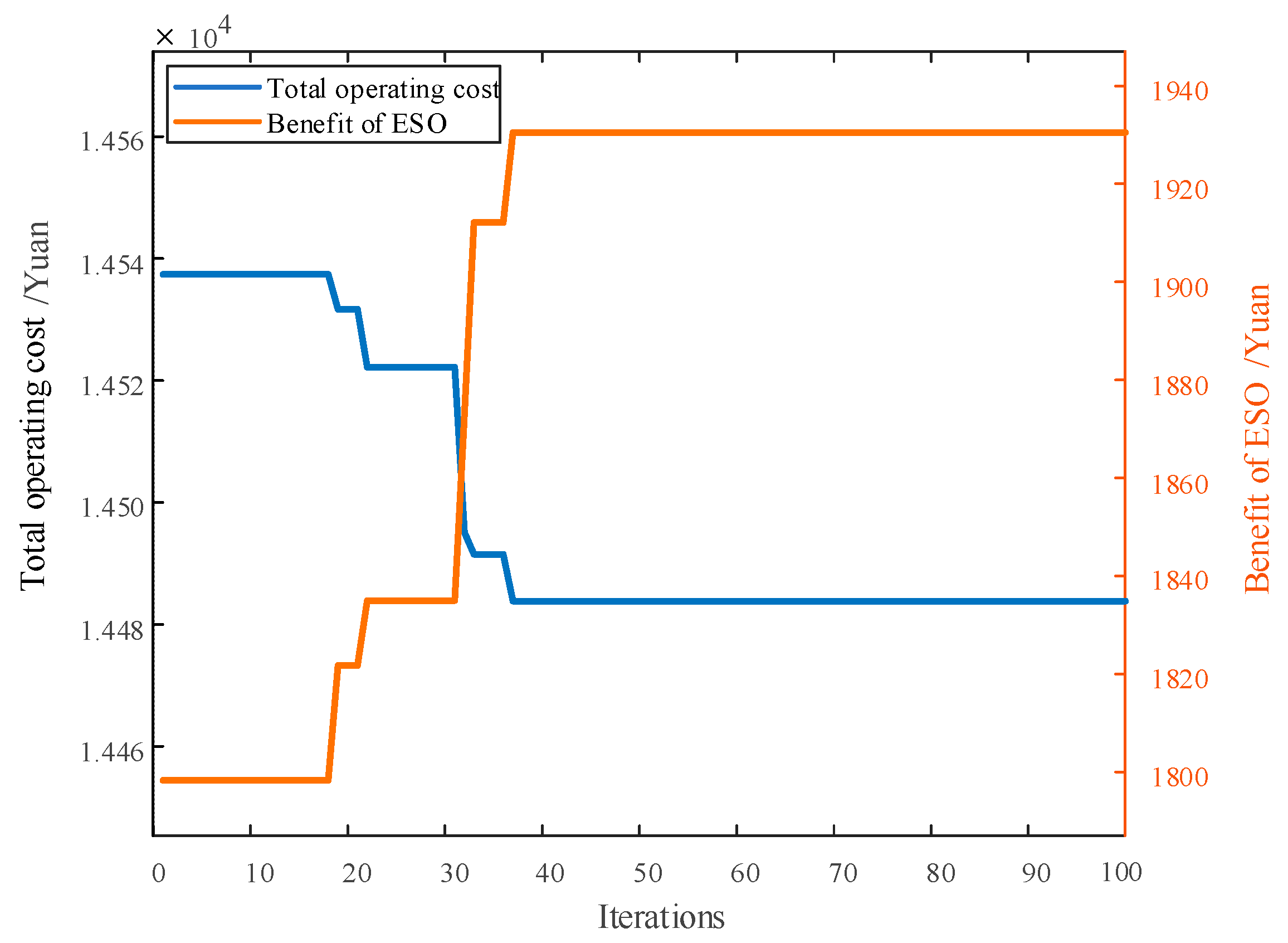1. Introduction
Currently, global building energy demand is still growing rapidly, and the carbon emissions from buildings account for a relatively high proportion of global emissions. The process of energy transition continues to face considerable difficulties. The building integrated energy system, as an energy production, supply, and consumption system integrating multiple heterogeneous energy sources, can leverage the complementary advantages among different energy systems, thereby achieving energy coupling at different links, optimizing the energy consumption structure of buildings and enhancing multiple energy source utilization, energy conservation, and carbon reduction. The collaborative optimization operation among multiple buildings can further improve the operation efficiency. In this context, strategic operation collaboration among multi-buildings is vital.
A rich body of literature has addressed the hierarchical decision-making mechanism of both distribution network operators and prosumers, including smart buildings. The superior distribution network first issues dynamic electricity price signals, and the subordinate prosumers employing integrated energy systems (IESs) adjust load demand based on this pricing strategy, ultimately achieving the flexibility equilibrium of energy supply and load demand. In the literature [
1], the supply–demand dynamics and energy conversion processes were analytically investigated within the framework of the sharing economy, with a specific focus on the dual roles of prosumers as both producers and consumers. A Stackelberg game theoretical model was formulated, wherein the IES assumed the role of the leader, while the prosumer operated as the follower. Reference [
2], based on the typical structure of distributed IESs, introduced IES operators and proposed an electricity and heat energy trading framework with the operators as the leader and the distributed IES as the follower in order to enhance the operator’s profit and mitigate the system cost and carbon emissions. The model is built in based on the Stackelberg game model, and the existence of Nash equilibrium is proved. Reference [
3] proposed a Stackelberg game model for a community IES considering carbon trading and demand response, with community integrated energy service providers as the leader and user aggregators as the followers. Reference [
4] established a coordinated scheduling model for microgrids and electric vehicles based on the Stackelberg game. In Reference [
5], a Stackelberg game-theoretic framework was proposed to address the optimal configuration and service pricing problem in an electricity–heat cloud energy storage system. The hierarchical leader–follower interaction was subsequently transformed into a tractable single-layer optimization model through the application of Karush–Kuhn–Tucker (KKT) optimality conditions.
In the electricity market transactions, different stakeholders display competitive relationships. They are all independent rational entities and exhibit an equal cooperative relationship [
6]. Therefore, in the research regarding multi-combined energy system optimization, the cooperative revenue distribution among the participating entities and the overall revenue improvement must be considered [
7,
8]. Reference [
9] established an IES optimization model inspired by the cooperative game theory, using the asymmetric Nash bargaining method to ensure that cooperative revenue is properly dispensed in alignment with contribution, solving the bargaining model using the ADMM algorithm. Reference [
10] constructed a tripartite collaborative game framework comprising government, enterprises, and users, quantifying the collective welfare optimal solution through the Nash bargaining theory and empirically demonstrated that this mechanism not only achieves Pareto improvement of alliance benefits but also significantly enhances the willingness of participating entities to cooperate by designing an incentive-compatible revenue distribution mechanism. Reference [
11] proposed a Nash–Harsanyi bargaining game revenue distribution method which focused on equality and renewable energy acceptance and designed a random hierarchical optimization method to optimize the multi-operator, multi-energy interaction, inlcuding multi-RIES operation strategies with multiple uncertainties. Reference [
12] proposed a coalition division strategy based on regional energy endowment, achieving cross-regional backup resource sharing through a multi-level coalition game architecture. Reference [
13] considered comprehensive demand response and carbon trading mechanisms to establish a decentralized energy exchange structure obeying cooperative game theory and distributed optimization algorithms. As for the uncertainty of renewable energy, the accuracy of renewable energy prediction results was quantified in the benefit distribution process, thereby improving the traditional Shapley value method to achieve fairer and more reasonable profit coordination.
Based on the non-cooperative game and cooperative game theories, conducting mixed game research in the integrated energy system has become an important direction [
14]. Reference [
15] proposed a multi-agent low-carbon optimal scheduling model based on the mixed game strategy, aiming for economic optimality and introducing carbon emission flow as a constraint, effectively guiding the low-carbon economic operation of multiple RIES. A mixed game theoretical framework for IES was proposed [
16], incorporating regulatory agencies as exogenous stakeholders. The model synthesized hierarchical Stackelberg interactions—in which the IES operator acted as the leader, while the energy storage systems and end-users constituted the followers—under regulatory constraints. To achieve this multi-agent equilibrium, the study employed a composite solution methodology combining game theory with a divide-and-conquer algorithmic paradigm, thereby deriving optimal strategic responses for all participants under regulatory oversight. Additionally, a multi-IES three-layer mixed game optimal control strategy was proposed [
17], taking into account multiple uncertainties. Chance-constrained programming and robust optimization methods were employed to tackle the uncertainties associated with renewable energy and electricity prices. The Stackelberg game between the IES and the energy producers was resolved by integrating KKT conditions with the Big M and McCormick methods. Meanwhile, the cooperative game between the energy producers and the IES was addressed by utilizing the ADMM algorithm. A two-tier coordinated control strategy model was devised for the IES encompassing electricity, heat, and gas in Reference [
18], which was founded on multi-agent deep reinforcement learning. Specifically, the upper tier of the model constructs a multi-agent mixed game decision-making framework, leveraging the multi-agent deterministic policy gradient algorithm. Meanwhile, the lower tier established a computation model that incorporated power and gas flow dynamics. This dual-layer approach effectively addressed the high-dimensional nonlinear optimization challenges inherent in complex coupled networks. Reference [
19] hypothesized that extending the energy boundary from the building-integrated photovoltaic system to e-mobility is an effective alternative to further improve integrated energy system performance. Reference [
20] constructed a novel two-layer energy dispatching and collaborative optimization model for a regional integrated energy system considering the stakeholders game theory and flexible load management. Reference [
21] proposed a master–slave game-based optimization strategy for pricing and scheduling within integrated electricity–heating energy systems. Initially, the transactional model between integrated energy operators and load aggregators is presented. Second, a master–slave game model for the integrated electricity–heating energy system is developed.
Overall, although existing studies have conducted numerous investigations on the optimal operation of building integrated energy systems, as summarized in
Table 1, few have addressed mixed game strategies for multi-building collaborative operation considering multi-agent benefits and uncertainties simultaneously. Moreover, uncertainties regarding sources and loads and their impacts on multi-building system decision making have been extensively addressed using scenario-based stochastic or robust optimization, which lacks model-tractable chance-constrained formulation. Focusing on these research gaps, this paper proposes a bi-level day-ahead operation model for multi-buildings considering mixed games and uncertainties. Specifically, the Stackelberg game, which is a non-cooperative game, is employed for modeling the non-cooperative interaction between the energy operator and multiple buildings. The energy operator, as a leader in the non-cooperative game, maximizes its operational revenue, while building agents, as followers in the non-cooperative game, aim to minimize their own operation costs. In addition, cooperative game theory is employed for multiple building agents, which allows for energy exchange to optimize their overall costs. The main contributions of this paper are summarized as follows:
(1) A mixed game-based day-ahead operation strategy for multi-building systems is established that incorporates both Stackelberg games and cooperative games. The operation strategy is modeled using a bi-level optimization model, where the upper level maximizes benefits of the ESO, and the lower level minimizes the operation benefits of buildings.
(2) To address the uncertainties in distributed renewable generation and loads, the fuzzy chance-constrained program is employed for the established operation model. Further, an analytical model reformulation approach is presented to reformulate the fuzzy chance-constrained program into a tractable deterministic model.
(3) In consideration of the solution challenges due to the mixed-binary variables in the established bi-level optimization model, a hierarchical solution approach is presented.
The remainder of this paper is configured as follows.
Section 2 introduces the energy structure and equipment models in buildings.
Section 3 establishes the mixed game-based bi-level day-ahead operation model.
Section 4 presents solution approaches and Shapley value-based benefit allocation.
Section 5 presents case studies, and
Section 6 draws conclusions.
5. Case Studies
5.1. Case Data
We conduct case studies on multiple building integrated energy systems within a certain “smart town” in East China. The multi-building system consists of three buildings that are located adjacent to each other under the management of the same energy operator. The buildings are connected through a heat pipe network to achieve the heat energy exchange between them. The energy flow and equipment within each building are shown in
Figure 1, including equipment such as distributed PV generators, gas turbines, electric boilers, battery and heating energy storage, etc. Note that we ignore the network constraints within energy systems. We select one day with an hourly resolution for the multi-building system for the case studies. The daily load and renewable generation data in each building are presented in
Figure A1,
Figure A2 and
Figure A3 in
Appendix A. The quantity and technical and economic information for the equipment in each building is presented in
Table A1 in
Appendix A. The TOU electricity prices from the power grids are shown in
Figure 5. The prices of electricity exchange between the ESO and the buildings are to be optimized. To better demonstrate the cooperative game-based cooperation among multiple buildings, we select three buildings for operation and compare the effectiveness of the cooperative game-based scheduling among three buildings and that for only two buildings.
5.2. Case Study Results
The optimal prices of the upper-level leader ESO are illustrated in
Figure 5. In
Figure 5, the black dotted line and the orange dotted line represent the time-of-use electricity price that the ESO purchases from the superior power grid and the grid-connected electricity price that the ESO sells to the superior power grid, respectively. The ESO formulates its price strategy within the two price ranges to provide a more favorable price for the BIES cooperation alliance compared to that of the power grid.
The results of the thermal power interaction scheduling by the BIES cooperative alliance are shown in
Figure 6. The results in
Figure 6 reveal that the thermal energy supply of both building 1 and building 2 expressed an over-supply state for most time periods, while the thermal energy supply of building 3 displayed an insufficient supply state for most time periods. Therefore, building 3 mainly received the interaction thermal energy from building 1 and building 2. Since building 3 was the main entity consuming the excess thermal energy in the alliance, it made a relatively high marginal contribution to the alliance. Thus, compared with building 1 and building 2, more benefits should be allocated to building 3, based on its degree of contribution in the final benefit distribution, which is consistent with the final benefit distribution result. After multiple buildings joined the cooperative alliance, the cost of external purchased energy decreased, stimulating energy complementarity sharing and collaborative optimization operation among the buildings. Through the thermal energy pipelines among the buildings, the optimized scheduling of thermal energy within the multi-building cooperative alliance area was achieved. The proposed strategy contributes to improving the overall economy, energy utilization efficiency, and overall flexibility of the multi-building integrated energy system.
5.3. Analysis of the Benefit Distribution Allocation
To verify the validity and accuracy of the proposed mixed game optimization model, four scenarios are set up for comparative analysis:
Scenario I: Each multi-building operates independently, adopting time-of-use electricity prices.
Scenario II: Each building interacts with the ESO, without cooperation among buildings.
Scenario III: Multi-buildings conduct mixed game optimization operation, without benefit distribution.
Scenario IV: Multi-buildings conduct mixed game optimization operation and adopt the Shapley value method for benefit distribution.
Table 2 shows the cost results when two buildings in the alliance cooperate. The cost results of each building in the BIES cooperative alliance under different scenarios are shown in
Table 3.
By comparing the results of Scenario I and Scenario III, it is noticeable that the operating costs of building 1, building 2, and building 3 in Scenario III have decreased by 530.3 CNY, 679.5 CNY, and 1558.1 CNY, respectively. The total operating cost of the BIES cooperation alliance has decreased by 2678.9 CNY, showing a reduction of 15.61%. This indicates that the adoption of mixed game optimization for operation can effectively reduce the total operating cost of the BIES cooperation alliance and enhance the economic efficiency of the system.
By comparing Scenario I, Scenario II, and Scenario III, it can be observed that when only the master–slave game (Scenario II) is adopted, the overall operating cost of the multi-building system decreased by 11.11%, while when the mixed game (Scenario III) is adopted, the overall operating cost of the multi-building system decreased by 15.61%. Compared with Scenario I, Scenario III has further decreased by 3.98%, and the revenue of the energy operator has further increased by 10.31% after adopting the mixed game. These outcomes show that the proposed mixed game strategy can further reduce the operating cost of the multi-building system and enhance the revenue of the energy operator.
Furthermore, compared with the mode in which multiple buildings operate independently under the time-of-use electricity pricing system, the system operation cost of the BIES using the mixed game optimization method has been reduced by 2812.8 CNY, accounting for 17.24% of the total cost. This indicates that through the lower-level cooperative game, each BIES optimizes the energy output of its internal equipment, reduces energy transactions with the superior power supply network by increasing energy interaction among the BIESs, and enhances the overall economic efficiency of the cooperative alliance. Moreover, the energy operator can obtain certain benefits.
From
Table 2 and
Table 3, it can be concluded that when building 1 and building 2 form a cooperative alliance and building 3 operates independently, the total operation cost of multiple buildings is 16,126.5 CNY. When building 3 joins the cooperative alliance, the total operation cost of multiple buildings becomes 14,485.1 CNY. Similarly, when building 1 and building 3 form a cooperative alliance and building 2 operates independently, the total operation cost of multiple buildings is 15,439.5 CNY. When building 3 joins the cooperative alliance, the total operation cost of multiple buildings becomes 14,485.1 CNY. When building 2 and building 3 form a cooperative alliance and building 1 operates independently, the total operation cost of multiple buildings is 15,482.8 CNY. When building 3 joins the cooperative alliance, the total operation cost of multiple buildings becomes 14,485.1 CNY. It can be seen that whenever a subject participates in the cooperative alliance, the total operation cost of the cooperative alliance can be reduced. The BIES cooperative alliance satisfies the superadditivity condition, which means it meets the overall rationality.
Furthermore, as can be seen from
Table 2 and
Table 3, when building 1 and building 2 cooperate, the total operating cost decreases by 1037.5 CNY, representing a reduction of 8.71%. When building 1 and building 3 cooperate, the total operating cost decreases by 1724.5 CNY, representing a reduction of 14.55%. When building 2 and building 3 cooperate, the total operating cost decreases by 1681.2 CNY, representing a reduction of 15.91%. At the same time, compared with the individual cooperation of building 1 and building 2, the energy operator gains more revenue when building 1 and building 3 cooperate with each other. It can be seen that the complementary characteristics of building 1 and building 2 are relatively weak, while the complementary characteristics of building 3 with the other two buildings are relatively strong. Participating in the cooperation alliance, building 3 can more effectively reduce the operating cost and obtain more revenue for the energy operator.
On the basis of meeting the overall rationality, we further analyze the individual rationality within the cooperation alliance. By comparing the results of Scenario I and Scenario III in
Table 2, we can see that the operating costs of building 1, building 2, and building 3 decrease by 530.3 CNY, 679.5 CNY, and 1558.1 CNY, respectively. Due to the different contributions of each building in the cooperation alliance during the cooperative operation, directly adopting the revenue distribution results of the mixed game optimization obviously does not meet the individual rationality. By comparing the results in Scenario I and Scenario IV in
Table 2, we can observe that after the revenue distribution using the Shapley value method, the operating costs of building 1, building 2, and building 3 decrease by 792.9 CNY, 771.2 CNY, and 1114.8 CNY, respectively. Therefore, before the distribution, the revenue and contribution degree of each building do not match. The revenue of building 1 and building 2 is relatively low, which may lead to the low motivation of building 1 and building 2 to participate in the cooperation alliance. It can be seen that using the Shapley value method for distribution, based on the marginal contribution of each building, can enhance the motivation of each building to participate in the cooperation alliance and effectively reduce the operating cost of each building.
5.4. Analysis of Impacts of Confidence Levels and Degrees of Fuzziness
5.4.1. Impacts of Different Confidence Levels
The cost results at different confidence levels are shown in
Table 4.
From
Table 4, it can be observed that as the confidence level “α” increases, the operating costs of the cooperative alliance continue to rise, and the revenue of the energy operator also keeps increasing. This indicates that the cost control and risk avoidance of the building integrated energy system are in conflict. When the confidence level is set higher, decision makers exhibit higher requirements for the validity of the fuzzy constraints. At this time, although the stability of building operation is better guaranteed, due to the relatively strict constraints, the economy of the building is reduced, the energy demand of the building increases, and therefore, the revenue of the energy operator also increases accordingly. when the confidence level is set lower, decision makers display lower requirements for the validity of the fuzzy chance constraints. At this time, although the building operation is more economical, it will significantly increase the potential risks of building operation, and the revenue of the energy operator also decreases due to the reduction in energy demand in the cooperative alliance. Therefore, in actual scheduling decisions, it is necessary to take into account multiple factors, such as the consumption of distributed new energy and the operational risks of buildings; to select a confidence level that is acceptable in terms of risk and displays lower building operation costs; and to formulate corresponding building optimization operation strategies.
5.4.2. Impacts of Different Degrees of Fuzziness
The operating costs of the multi-building system under different degrees of fuzziness were compared, where
, and the comparison results are shown in
Table 5.
From
Table 5, we can observe that as σ decreases, the degree of fuzziness continuously decreases, indicating that the prediction accuracy continuously increases. The total operating cost of the cooperative alliance has decreased from 14,131.8 CNY to 11,051.1 CNY, a reduction of 21.80%. The revenue of the energy operator has decreased from 1821.7 CNY to 1082.2 CNY, a reduction of 40.59%. It can be seen that the degree of fuzziness of the uncertain parameters of photovoltaic and diversified loads is positively correlated with the total operating cost of the system. The higher the degree of fuzziness, the lower the prediction accuracy and the more conservative the optimization result. Improving the prediction accuracy to reduce the degree of fuzziness of uncertain parameters can improve the economy of the system.
5.5. Solution Process
The solution process of the mixed game-based operation is shown in
Figure 7.
Figure 7 shows that the solution process converges after 37 iterations. The revenue of the ESO presents a positive correlation with the number of iterations, and the total operation cost of the BIES cooperation alliance gradually decreases. This reflects the game process between the two entities. During the iterative process, both entities adjust their strategies to maximize their own benefits. When the game reaches equilibrium, the game strategy no longer changes, indicating that in the current strategy, none of the building entities can further improve their economic benefits by adjusting their own strategies.
6. Conclusions
This paper proposes a mixed game-based day-ahead operation strategy for multi-building integrated energy systems. Specifically, a bi-level game model is established, in which the upper-level model maximizes the benefits of the ESO, and the lower-level model minimizes the operation costs of multiple buildings. Furthermore, in consideration of source-load uncertainties, the established bi-level operation model is reformulated into a fuzzy chance-constrained type. Subsequently, a hierarchical solution approach is presented to solve the bi-level optimization model, and the Shapley value is adopted for benefits re-allocation.
Case studies conducted on a multi-building system in East China verified the effectiveness of the proposed work, and the following conclusions can be drawn:
(1) The proposed game-based operation model contributes to reducing total operation costs by 3.98% and increasing the energy operator’s revenue by 10.31%.
(2) Through the Shapley value method, the operation cost of each building agent is re-attributed based on their marginal contributions, which enhances the motivation of each building to participate in the cooperation alliance and effectively guarantees the benefits of each building.
(3) The proposed fuzzy chance-constrained program effectively addresses source-load uncertainties, allowing for flexible day-ahead decision making according to different prediction accuracy and confidence levels.
(4) The presented hierarchical solution approach effectively solves the game-based bi-level model with mixed-binary variables.
The proposed work offers insights for building sectors in which building operators could participate in energy exchange with both building aggregators and other building sectors so that the overall operation costs could be effectively reduced. In the future, this work could be extended by establishing more accurate equipment models, e.g., disparate timescales between fast electrical response and slow thermal inertia. Moreover, this work is limited by its focus on only electricity, heating, and cooling systems. The proposed work could be extended to more complicated integrated energy systems by incorporating other energy systems, e.g., hydrogen systems.

